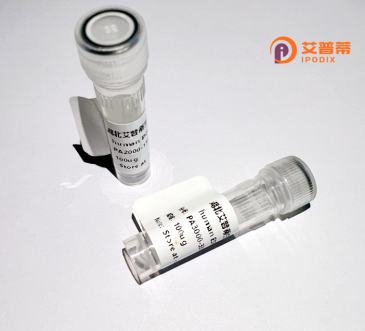
| 纯度 | >90%SDS-PAGE. |
| 种属 | Human |
| 靶点 | SPDYA |
| Uniprot No | Q5MJ70 |
| 内毒素 | < 0.01EU/μg |
| 表达宿主 | E.coli |
| 表达区间 | 1-313aa |
| 活性数据 | MRHNQMCCET PPTVTVYVKS GSNRSHQPKK PITLKRPICK DNWQAFEKNT HNNNKSKRPK GPCLVIQRQD MTAFFKLFDD DLIQDFLWMD CCCKIADKYL LAMTFVYFKR AKFTISEHTR INFFIALYLA NTVEEDEEET KYEIFPWALG KNWRKLFPNF LKLRDQLWDR IDYRAIVSRR CCEEVMAIAP THYIWQRERS VHHSGAVRNY NRDEVQLPRG PSATPVDCSL CGKKRRYVRL GLSSSSSLSS HTAGVTEKHS QDSYNSLSMD IIGDPSQAYT GSEVVNDHQS NKGKKTNFLK KDKSMEWFTG SEE |
| 分子量 | 36.4 kDa |
| 蛋白标签 | His tag N-Terminus |
| 缓冲液 | PBS, pH7.4, containing 0.01% SKL, 1mM DTT, 5% Trehalose and Proclin300. |
| 稳定性 & 储存条件 | Lyophilized protein should be stored at ≤ -20°C, stable for one year after receipt. Reconstituted protein solution can be stored at 2-8°C for 2-7 days. Aliquots of reconstituted samples are stable at ≤ -20°C for 3 months. |
| 复溶 | Always centrifuge tubes before opening.Do not mix by vortex or pipetting. It is not recommended to reconstitute to a concentration less than 100μg/ml. Dissolve the lyophilized protein in distilled water. Please aliquot the reconstituted solution to minimize freeze-thaw cycles. |
1. **"SPDYA interacts with Cyclin-Dependent Kinases and regulates cell cycle progression"**
*Author: Schmidt A, et al.*
摘要:研究揭示SPDYA通过结合CDK1/2调控G1/S期转换,促进磷酸化下游靶点(如RB蛋白)驱动细胞周期进程。
2. **"Speedy/RINGO A regulates oocyte meiotic maturation in mammals"**
*Author: Zhang Y, et al.*
摘要:验证SPDYA在小鼠卵母细胞减数分裂中的作用,表明其通过激活CDK1调控纺锤体组装和染色体分离。
3. **"Overexpression of SPDYA in cancer cells enhances proliferation and chemoresistance"**
*Author: Lee JH, et al.*
摘要:发现肝癌细胞中SPDYA过表达激活CDK通路,促进增殖并抑制化疗诱导的凋亡,提示其作为肿瘤治疗靶点。
4. **"SPDYA mediates DNA damage repair via CDK-dependent phosphorylation cascade"**
*Author: Gupta R, et al.*
摘要:阐明SPDYA在DNA损伤修复中的机制,通过招募CDK1/2磷酸化BRCA1等修复蛋白,维持基因组稳定性。
**Background of Recombinant Human SPDYA Protein**
SPDYA (Speedy/RINGO Cell Cycle Regulator A), also known as Speedy A, is a conserved protein belonging to the Speedy/RINGO family, which plays a critical role in cell cycle regulation. Unlike classical cyclins, SPDYA lacks a cyclin box domain but retains the ability to activate cyclin-dependent kinases (CDKs), particularly CDK2. facilitating cell cycle progression, especially during the G1/S phase transition. It is implicated in mitotic entry, meiosis, and DNA damage response pathways.
SPDYA's expression is tightly regulated during development and varies across tissues, with higher levels observed in germ cells and certain cancer types. Studies in model organisms (e.g., *Xenopus*, mice) highlight its essential role in oocyte maturation and embryonic development. Dysregulation of SPDYA has been linked to cancer progression, as overexpression promotes uncontrolled proliferation, genomic instability, and resistance to apoptosis, suggesting oncogenic potential.
Recombinant human SPDYA protein is widely used in biochemical assays, structural studies, and functional analyses to explore its interaction with CDKs, substrate recognition, and regulatory mechanisms. Its recombinant form enables research into therapeutic targeting, particularly in cancers where SPDYA overexpression correlates with poor prognosis. Additionally, SPDYA's unique CDK activation mechanism offers insights into alternative cell cycle regulatory pathways, expanding understanding beyond canonical cyclin-CDK paradigms.
×